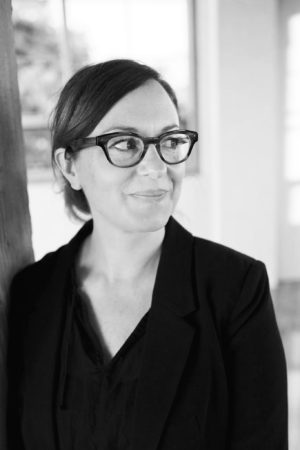 Name: Jennifer Fowler
Name: Jennifer Fowler
Company / Position:Â Hacker / Director of Interior Design
Years of Experience:Â 17 years
IIDA Member Since: 2015
What are you currently working on? We are fortunate to have a huge variety of projects at Hacker. Currently, we are working on a handful of commercial workplace projects as well as higher ed, K-12, cultural arts, residential, and local mixed-use buildings.
Tell us a bit about your creative process: I’m at the table early – day one, understanding the landscape and light; contributing to discussions on building skin and glazing patterns. Interior design is at the heart of how an end user experiences space. I am frequently perplexed at how often this design process is addressed too late or as an afterthought. When interior design is integral to the creative process, we’re able to respond attentively to the program to thoughtfully capture the experience of the user – and hopefully also exceed their expectations by creating an experience that is compelling in some unexpected way. The form of the building can be a response to that focus on the interior – designing from the inside out and simultaneously the outside in. I’m extremely fortunate to work with architects who are aligned with my thinking. Together, we are shifting our studio’s culture so that architects are putting on an interiors hat too: just as I do better work thinking about the site, daylighting, building form, the architects do better work when they also are thinking about the interior experience. This reciprocal design process is fundamentally missing in the way architecture and interiors have been taught. We are changing this, and seeing better work for it.
What project have you worked on that you are most proud of? While at BORA in 2006, I worked on a very special school, Reynolds School District Four Corners, in Portland. The project involved the rehabilitation of an old, tilt-up racquetball club into a K-5 school for special-needs kids. Their “special needs†were utterly heart-wrenching; many children having lost their parents, or being so psychologically or emotionally wounded that they were one step away from being institutionalized. Our task was critically clear: we needed to come together to provide a warm and safe place for the children, a place where they will feel comfortable to learn and attend class every day. Learning about the dynamics of their education, I was in awe of all of the amazing teachers and staff who dedicate themselves to the school. During the design process, I researched the psychology of color and its effects on children at various ages and stages of development in order to thoughtfully incorporate the results into the appropriate classrooms. With the tiniest budget imaginable, we worked tirelessly to come up with design solutions that resulted in a light-filled, up-lifting space with a soothing yet playful material palette. We designed a double-height wall that slipped from the exterior at the entry to the interior, filled with a grid of color and magnetic tiles for the kids’ artwork to be displayed continuously throughout the year. It is a highly secure, locked campus so unfortunately I’ve never had the opportunity to see children in the interior environment. Nevertheless, it has personally been one of my most rewarding projects.
On a typical Saturday where can we find you? Spending time with my husband and son, typically building Legos, then on to a hike or outing.
Why are you a member of IIDA? I am a member of IIDA so that myself and our team at Hacker can engage with the rich community and culture of design in Portland. I respect the IIDA mission and know that it brings a lot of value to our commitment to design. I want to support that effort.
